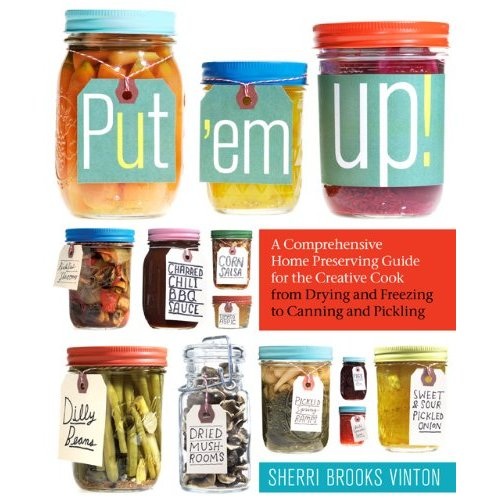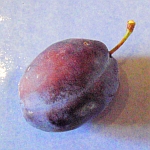by Kerry Knight

When the back to school commercials start popping up on your TV you know fall is right around the corner. For the kiddies, September brings with it the promise of new Duo Tangs, old verbs waiting to be conjugated and the horrors of showering with the rest of your P.E. class. Adults know that although summer is kissing us goodbye, autumn is preparing to greet us bearing gifts of the earth. While we were lazing around all July and August, Mother Nature, in conjunction with folks who really work for a living, was busy stuffing her cornucopious bra.
But it is not just autumn that presents us with such a bounty; in Spring we are serenaded by fiddleheads and ramps and asparagus. Throughout the summer we celebrate the arrival of fruit and glut ourselves during Bacchanalias of strawberries, cherries, pears and peaches. Early varieties of corn pop by, then Ol’ Ma Earth hits us with all she’s got.
In this four-season climate, it is feast or famine, anticipation and arrival, work and reward; the growing season is relatively short, then we are walloped with riches. Winter snowshoes in, and we are faced with tasteless tomatoes trucked in from banana republics and mutant styrofoam tasting strawberries from California.
Of course, there is an alternative.
Spring, summer and fall are the perfect time to can, to put up those gorgeous fruits and veggies that you have been gorging on and –dare I say it? -getting sick of.
This spring, while at Mark Lass’ farm selecting a piglet, a bunch of us went foraging for wild leeks. I returned with bundles of them that my wife, Ivy pickled. There is nothing like a grass fed hamburger garnished with pickled ramps!
I was recently in St John’s Newfoundland and returned with mason jars of bakeapple jam, blueberry preserves and partridgeberries all lovingly preserved. You want moose? We got jars of it, canned by the good folks at Bidgoods just outside of St. John’s. On my birthday in mid-August, friends Trish Donnelly and Renée Bellefeuille gave me jars of homemade peach preserves, peach and corn relish and rhubarb-mixed berry jam, so my pantry is overflowing.
It seems everyone is putting up preserves these days. Let me list the reasons:
- It is economical;
- Canning is fun;
- The stuff tastes better;
- You know what you’re eating;
- It is in keeping with the current buzzwords “local” and “slow food”; and
- The mason-jar jewels make charming (and cheap) presents for all occasions (thank you Trish and Renée).
This is all well and good if you have the time, or you learned the art of canning at your granny’s knee, but if you are a neophyte canner, you may be a little intimidated to try pickling those peppers. The internet can help you out of course, but there is nothing like a good book to peruse, ogle and drool over, then crack open and spill sugar and vinegar on.
Put ’em Up!: A Comprehensive Home Preserving Guide for the Creative Cook, from Drying and Freezing to Canning and Picklingis one of those books that is so well written and user friendly that you will be tempted to tackle several of the recipes within. Written by Sherri Brooks Vinton, Put ‘em Up- a comprehensive home preserving guide for the creative cook is exactly that. It is in fact, the idiot’s guide to preserving. Well written, in an encouraging and humorous tone, the reader gets the feeling that Sherri Brooks Vinton is not an insufferable nerd, she wont bore you to death with pontifications about sustainability or terroir, and she doesn’t try too hard to convince you that what you are undertaking is more than what you thought it would be. As she reminds us in her introduction “…above all, relax and enjoy. Good food is for everyone. Cooking is easy and fun, so get into that kitchen and put ‘em up!”
The book is ingeniously designed and organized into two major sections.
‘Part One: Techniques’ is 100 pages long and includes sections on “Food Preparation” (Blanching, Jams and Jellies, Vinegar Pickles, Fermented Pickles, Salsa, Chutneys and Relishes, Butters, Sauces and Ketchups), Food Preservation, (Refrigeration, Freezing, Infusion, Drying, Boiling -Water Method) “Working in Groups”, “Things That Will Surely Get You Into trouble” and the reassuring, ”Things That Look Bad But Aren’t Dangerous” and may or may not go bump in the night. A hundred pages of technical instruction might seem a bit off-putting at first glance, but Ms Brooks Vinton writes with a light touch that is a pleasure to read, and the text is accompanied by full colour photographs of the finished product. Beautiful hand-picked illustrations a la Cooks Illustrated, by Elara Tanguy take you step by step through the various stages.
The remaining two hundred pages contain over 150 recipes, alphabetically arranged from Apples to Zucchini. Each recipe is pared into 3 sections: “Ingredients”, “Prepare” and “Preserve”-which has an icon or two referring you back to a particular methodology, for example, “Can (p. 79) Use boiling water method”
Whether you want to make your own Mincemeat, Apple Brandy, Red Hot Vodka or Mardi Gras Doubloons, the instructions are explicit and straightforward, the teaching method consistent and the anticipated results will make the effort worth it.
Having already tested a couple of the recipes, I can say that it is a fun and worthwhile way to spend a weekend. When Monday rolls around you can pack the little demons off to school with something special for Show and Tell and go get pickled. After all, most of your Christmas shopping is done. This book is a keeper, and deserves a place of honour on your shelf, maybe next to the jars of Martini Onions; you know you’ll be reaching for those.
Since the book is written ostensibly for beginners, Brooks Vinton often alludes to the possibility that your efforts may not win you a ribbon at the local fair on your first attempt, and offers suggestions on how to salvage your efforts. However, should you master these techniques, first class honours are undoubtedly just around the corner, perhaps at the Harrow Fair.
A four-day affair, the Harrow Fair recently celebrated 156 years, this Labour Day. Yes, that is older than Canada itself. Harrow is located in Essex County in South Western Ontario, nestled between Lake Erie and Lake Saint Clair, and shares the same latitude as Northern California and Tuscany, so you can tell that to your smirking American cousins the next time they wisecrack about your skiing in July. If you missed this year’s festival, you can still attend the awards night on December 03 to see what you’re up against.
In the meantime, check out The Harrow Fair Cookbook: Recipes Inspired by one of Canada’s Oldest Country Fairs by Moira Sanders and Lori Elstone, two sisters that are part of the MacDonald family that has been in Harrow for six generations. The book reflects that heritage, written with pride and a love of land and lake and the people who call it home.
The book features award winning recipes from the sisters themselves, and they have managed to pry and publish the family secrets of other winning recipes as well.
All the recipes feature ingredients from “The Sun Parlour of Canada”; jams, jellies, and pickles of course, sweet corn fritters, skillet-baked Lake Erie buttered pickerel, pan-fried perch, smoked trout dip… Perhaps you want to serve this with a seven strata salad, or summer pea soup. Warm up with a watermelon martini and finish with strawberry shortcake ice cream. The recipes are straightforward and the writing is as refreshing as picnic table ice tea with basil.
If you are looking for a cookbook that captures the charm, tradition and essence of this country during what many consider the most beautiful season, you will find it on each and every page.
* * *
If these books get you in a preserving mood be sure to set a few jars aside for a very special evening Ivy is hosting at the Drake on Sept. 27th. An exciting new food and wine website will be launching that night and a Preserves Swap will be on the agenda for the launch. It’s free, open to everyone and not to be missed. For more info go to www.ivyknight.com.
 Kerry Knight is a starving writer who has been eating all his life. Growing up in a family with eight others, he learned to read devouring the collected works of Kate Aitkin and Mary Moore. He lives in Parkdale and regularly cooks for his wife Ivy and his three dogs, Poppy, Betty and Peabody. Follow Kerry Knight at twitter.com/keppsterr.
Kerry Knight is a starving writer who has been eating all his life. Growing up in a family with eight others, he learned to read devouring the collected works of Kate Aitkin and Mary Moore. He lives in Parkdale and regularly cooks for his wife Ivy and his three dogs, Poppy, Betty and Peabody. Follow Kerry Knight at twitter.com/keppsterr.









Trackbacks/Pingbacks